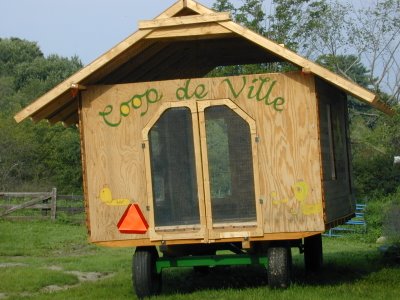I’m hoping to chronicle my experiences and thoughts raising broiler chickens this year and over the last two years in a series of posts over the next few months. I plan on covering everything from brooding to butchering.
Once chicks are a few weeks old they do not need the extra heat supplied by their mothers or heat lamps and can go outdoors. For the most part commercially raised meat chickens never have the opportunity to ever be outside. They spend their entire lives indoors in cramped quarters in broiler houses with tens of thousands of other chickens. This is not the way I want the chickens I eat to be raised. Why I think this is better will be the topic of another post, but today’s post is about the shelter the chickens will have. Even though they roam and forage in the pasture during the day, they need a place that is safe from predators and weather to sleep in at night.
The first year Judy and I did chickens, I built a movable pen. This is a popular was to raise pastured poultry made famous by Joel Salatin. The pen has no floor and is moved to a new area of pasture each day, giving the chickens fresh pasture and leaving the droppings behind to fertilize the pasture. One of the problems with this idea was getting the pen light enough to move, but not so light as to fall apart. I built it 8x8 feet by 2 feet high. Sadly it ended up too heavy for us to move easily on hilly terrain AND it fell apart. It didn’t last long enough to even get a picture of it I then built two smaller pens half the size with the pieces from the broken first pen. That worked as far as the pens being easy to move and light, but we soon decided we didn’t like the pen idea. The pen required moving too frequently and the chickens seemed like they would be better off with more pasture. We started to let the chickens out of the pens during the day and only put then in at night. This seemed to work better and meant that the pens did not require moving as much because the dropping from the chickens during the day were not in the pen, but spread out over the pasture. This system is called day range. Ithe one that I prefer and has worked well for the last two years.
The chickens I am doing with Heidi this year will also be day-ranged. Last year Judy and I built a new pen for the chickens that we think worked well. In this picture it’s missing a tarp that would cover it if there were chickens living it. It’s bottomless and made on wooden runners. It needs a truck to pull it to new pasture space. It was moved about once per week to fresh pasture. By substituting clear plastic for the tarp, this pen can be also be used as a greenhouse to start seedlings in spring. The red thing inside is actually a cold-frame.

Below is the pen that was built for the chickens Heidi and I will do his year. It’s quite fancy and I heard it won a trophy in the local 4th of July parade. I think it’s solidly built and with its real wheels is very transportable. One change that I think I would have made if it were my pen, is that I would have not built a solid floor. A bottomless pen needs no shoveling out. I think I’d prefer to let gravity do the work of manure spreading. This year’s chicks haven’t arrived yet so I can’t really say how much cleaning out it will need. Things never go exactly as predicted anyway and time will tell what Heidi and I think worked well and what might be changed.

The new chicks are scheduled to arrive this week and I must say I’m excited and look forward to learning more about raising broilers on pasture. They are White Rocks. In the past I raised Cornish Cross chickens and I’m really curious as to the differences between the two breeds.
Speaking of growing in a small lot, did you see this: http://www.sfgate.com/cgi-bin/article.cgi?f=/c/a/2006/07/22/HOGTMK219B1.DTL
ReplyDeleteThis family raises 3 TONS of food per year in 1/5 acre in Pasadena. Amazing.
(Your coop designs are very cool).
I had no idea you raised chickens! Or maybe I did but forgot. That's a very clever arrangement, to brood at your place and pasture when they're older.
ReplyDeleteWe have our first flock of 27 and they'll be old enough to butcher in 2-4 weeks. I'm half dreading it (especially the killing), half curious to see what it will be like, and very curious to see how they taste. I figure we'll do four our first time. Enough to make our efforts worthwile but not so many that we'll be overwhelmed. Do you butcher your own? How long do you age them in the fridge before they go into long term storage? Do you freeze them? Can them?
Yeah, I know. Join us for the following exciting episodes! Looking forward to them.
I really admire this, I mean it really looks interesting! Very nice research. Thanks to the author.
ReplyDelete